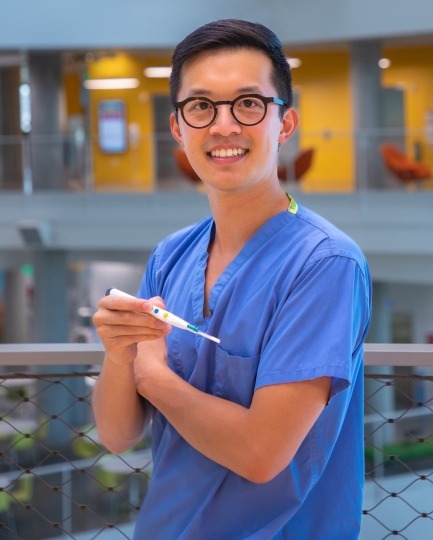Alex Yang, S.B. '17, founded ClearCut Surgical while pursuing his MD/MBA at Harvard.
Where there’s surgery, there’s blood. Every day, surgeons use electrocautery pencils in countless surgeries to open incisions and dissect tissue. But cutting into an organ inevitably causes blood to pool in the wound, blocking the surgeon’s view and causing a delay in the operation while the blood is suctioned away.
Alex Yang, S.B. ‘17, is trying to streamline that process with a new device that’s both an electrocautery pencil and suction tube. He founded ClearCut Surgical earlier this year to produce the device, and his company has secured pre-seed funding from multiple investors.
“Our ultimate goal is to try to get this device into the hands of every surgeon around the world, because this device would be used in every surgery,” said Yang, who is about to begin his last year in the MD/MBA program run jointly by Harvard Business School (HBS) and Harvard Medical School (HMS).
Yang first devised the ClearCut device as an undergraduate studying bioengineering at the Harvard John A. Paulson School of Engineering and Applied Sciences. He spent the summer after his junior year working in the Innovation Digital Health Accelerator at Boston Children’s Hospital, which is how he met Heung Bae Kim, Professor of Surgery at HMS and Weitzman Family Chair in Surgical Innovation at Boston Children’s. Kim and Yang got to chatting, and the challenges of blood accumulation during surgery eventually came up.
“This isn’t a new problem,” Yang said. “Many surgeons have been dealing with this problem for decades. Over the years, Kim had tried to jury-rig a solution, but our serendipitous meeting was finally the catalyst for us sitting down to think about creating a new device.”
From these conversations, ClearCut was born. The handheld device uses buttons to switch between electrocautery pencil and suction tube. The injection-molded plastic device doesn’t require additional electric power, switching functions with a pneumatic piston that connects to the vacuum suction in the wall of the operating room. These innovations keep the cost low, which could help make the device accessible to hospitals in lower-resource areas of the world.
“This device has probably gone through over a hundred iterations and 3D printed designs,” Yang said. “Surgeons are understandably picky, and you really only have one shot to get it right. If the button position is slightly off, or fails one out of a hundred times, or the device feels too clunky, you lose the surgeon right there. For a while, it was 80 to 90 percent there, but we wanted to make it sure it was 100 percent.”
Yang has spent the last six years slowly developing the device while pursuing his MD/MBA, soliciting feedback from multiple surgeons within Boston Children’s Hospital. He founded his company in March, and soon after won $30,000 as both Runner-Up and Crowd Favorite at the HBS New Venture Challenge. More recently, ClearCut Surgical was selected as one of 50 start-ups for the MedTech Innovator and Accelerator Challenge, which will announce its prizes in October.
“They’re the biggest medtech accelerator in the world,” Yang said. “It’s very hard to find a cohort that’s that concentrated and has that many resources. It’s great access to capital, manufacturing partners and industry partners all in one place.”
Designing a device is nothing new for Yang. His senior capstone project, a pediatric lower-limb prosthetic device, won a 2017 Dean’s Award for Outstanding Engineering Project.
“My dad is an architectural model maker and has spent his life building miniature buildings,” Yang said. “From when I was 5 or 6 years old. I was playing around in his workshop with tools, and he’s definitely been an inspiration.”
ClearCut still has to be approved by the U.S. Food and Drug Administration, a process Yang said will likely take at least one more year. He’s eyeing early 2025 for the company’s first commercial roll-out.
Once ClearCut does become available, Yang believes its low cost and ability to solve such a common surgical challenge will make it a hit for surgeons around the world.
“One of the options would’ve been to take the idea, file a patent, and license or sell it to a large medical device company,” Yang said. “But given my experience at SEAS and my engineering know-how, I thought it would be a better use of my time and our money to do it myself and take it as far as I could.”
Press Contact
Matt Goisman | mgoisman@g.harvard.edu
